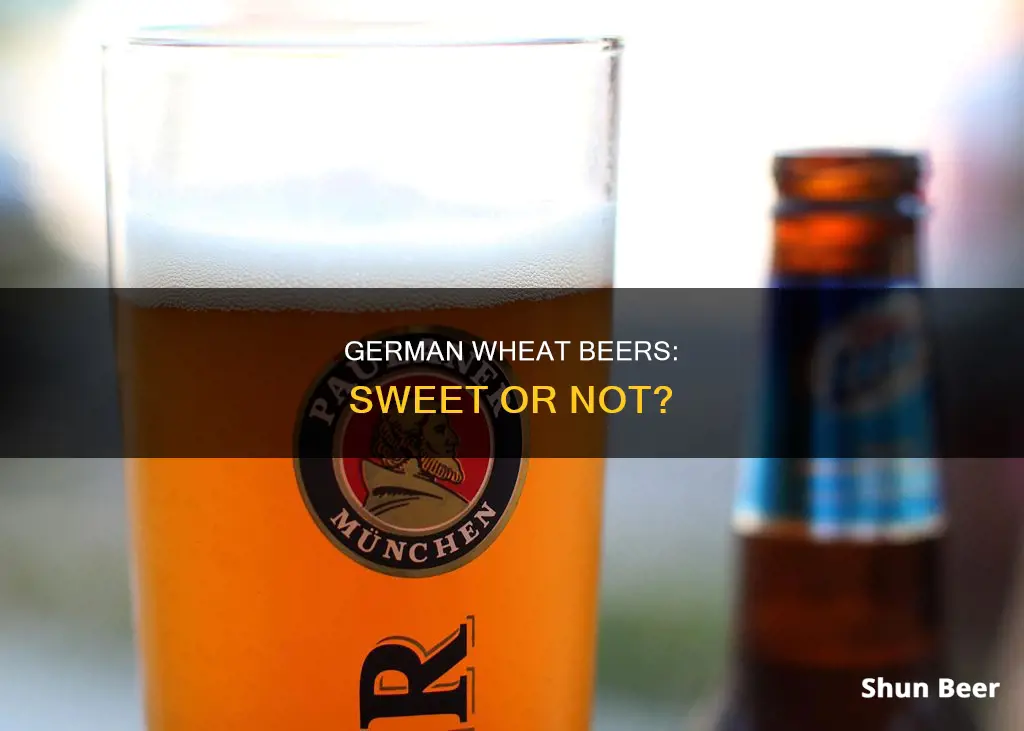
German wheat beers, also known as Weizenbier or Weißbier, are top-fermented beers brewed with a large proportion of wheat. They are characterised by their fruity and spicy flavours, with banana and clove being the most prominent. German wheat beers can be further categorised into light and dark colours, with the dark varieties known as Dunkelweizen. The intensity of the flavour profiles varies depending on the brewer, but the beers typically have a balanced taste. German wheat beers are highly carbonated and have a fluffy mouthfeel, with a relatively dry finish.
| Characteristics | Values |
|---|---|
| Appearance | Cloudy, straw to amber in colour |
| Flavour | Fruity (banana), phenolic (clove), sweet, malty |
| Alcohol content | Low to moderate |
| Bitterness | Low to moderately low |
| Carbonation | High |
What You'll Learn

German wheat beers are sweet due to the absence of hop bitterness
German wheat beers are known for their sweet taste, which is due to the absence of hop bitterness. This unique characteristic sets them apart from other beers and contributes to their widespread popularity.
Wheat beers, including German varieties, are typically light in colour, with alcohol content ranging from low to medium. They are often cloudy or clear in appearance, depending on the specific variety. One of the key features of German wheat beers is their use of a significant proportion of wheat in the brewing process, with at least 50% of the grist being malted wheat, and some versions using up to 70%. This high wheat content imparts a distinctive flavour and aroma, which can be described as bready, doughy, or grainy.
The absence of hop bitterness in German wheat beers is a deliberate choice to showcase the flavours contributed by wheat and yeast. The hops used in these beers are selected to provide a refined hop character that complements rather than overwhelms. Brewers aim for a low bitterness level, typically ranging from 10 to 35 IBUs (International Bitterness Units). This lack of bitterness enhances the drinkability of German wheat beers, making them accessible and enjoyable for a wide range of beer enthusiasts.
The sweetness perceived in German wheat beers is a result of this absence of hop bitterness, rather than any significant residual sweetness in the beer. The low bitterness allows the other flavour notes to shine through, creating a well-rounded and flavourful drinking experience. The soft, bready, or grainy flavour of wheat, along with a slightly grainy-sweet malt character, contributes to the overall impression of sweetness.
Additionally, German wheat beers are known for their high carbonation, which further enhances their refreshing quality. They are also characterised by fruity esters, typically imparting banana and clove flavours. The combination of these flavours with the absence of hop bitterness results in a unique and delightful beer style that has gained recognition beyond its German origins.
Blonde Ales and Wheat Beer: What's the Connection?
You may want to see also

Hefeweizen is a sweet German wheat beer
The Hefeweizen style is known for its low hop bitterness and relatively high carbonation, which balances the beer's malty sweetness. The sweetness of Hefeweizen is more due to the absence of hop bitterness than any actual residual sweetness. The beer has a distinctive banana-and-clove yeast character, with a soft, bready, or grainy flavour of wheat. The aroma and flavour of a Hefeweizen come largely from the yeast and are fruity, typically banana, and phenolic, typically clove. The intensity of these flavour qualities varies depending on the brewer, but they are most commonly balanced.
Hefeweizen typically contains a low to moderate alcohol content and is considered the most popular among the German wheat beer varieties. It is best served in a large, curvaceous glass, known as a "Weizen vase", which showcases the beer's beautiful glow and corrals its large, persistent foam cap. The bright fruitiness of banana and the pungency of clove make Hefeweizen a versatile beer that pairs well with a variety of lighter foods, such as salads, seafood, and egg dishes.
Hefeweizen is a refreshing and fast-maturing beer that is best enjoyed when fresh. It has a striking appearance and offers a unique beer experience, making it one of the most recognisable and enjoyable beer styles in the world.
Wheat Beers: Are All Brews Created Equal?
You may want to see also

German wheat beers are fruity and spicy
German wheat beer, or Hefeweizen, is a traditional Bavarian wheat beer brewed with at least 50% wheat malt and yeast that produces a signature clove and banana character. The low hopping rate allows an underlying, grainy, bready flavour from the wheat and Pilsner malt to come through. German wheat beers have a light, hazy appearance and a soft texture. They are highly carbonated and have a high level of protein and suspended yeast, which contributes to their cloudy appearance.
The ester and phenolic aspects of German wheat beer are produced by the special type of yeast rather than the high fraction of wheat in the grain bill. The yeast used in brewing German wheat beer produces overtones of banana and clove as by-products of fermentation. The phenolic character of German wheat beer has been described as "clove" and "medicinal" but also smoky. Other more typical but less assertive flavour notes produced by the yeast include "bubble gum" and sometimes "vanilla".
German wheat beer is known for its low hop bitterness and relatively high carbonation, which helps to balance the beer's relatively malty sweetness. The balance between bitterness and sweetness is usually even, though some examples may have an initial sweetness upfront. German wheat beer is best served fresh and consumed while young, as it doesn't age well.
Wheat Beer: What's the Deal?
You may want to see also

German wheat beers are highly carbonated
The carbonation level in wheat beers can range from 2.8 to 5.1 volumes of CO2, with an average of 3.9. This level of carbonation is higher than that of most other German beer styles and contributes to the voluminous foam that is characteristic of wheat beers.
The high carbonation in German wheat beers is achieved through bottle conditioning, where the beer is primed with corn sugar or wheat beer wort (Speise) before bottling. This process can be tricky, as the high carbonation level makes it difficult to dispense the beer from a keg. As a result, most commercial hefe-weizen beers are bottled rather than kegged.
The high carbonation also affects the flavour and mouthfeel of German wheat beers. The carbonation can enhance the perception of sweetness, as the absence of hop bitterness allows the beer to taste sweeter. Additionally, the high carbonation contributes to the fluffy, creamy texture that is characteristic of these beers.
Overall, the high carbonation of German wheat beers is an essential aspect of their unique flavour profile, mouthfeel, and appearance, making them highly refreshing and enjoyable beers.
Blue Moon Beer: Wheat or Not?
You may want to see also

German wheat beers are best served in a Weizen vase
German wheat beers, or Hefeweizens, are best served in a Weizen vase. This is a large, curvaceous glass that showcases the beer's beautiful glow and contains its large, persistent foam cap given the style's characteristic effervescence. The Weizen vase is also known as a vase-shaped glass, which is the traditional serving glass for Bavarian-style wheat beer.
The German-style Hefeweizen is a unique and recognisable beer style that offers a striking beer experience. It is brewed with at least 50% malted wheat and showcases yeast-driven fruit and spice flavours, as well as an uncharacteristic cloudy appearance. The aroma and flavour of a German wheat beer come largely from the yeast and are typically fruity (like banana) and phenolic (like clove). The intensity of these flavour qualities varies depending on the brewer, but they are most commonly balanced.
The Hefeweizen style is particularly noted for its low hop bitterness, which balances the beer's relatively malty sweetness. Another balancing flavour note unique to Hefeweizen is its phenolic character, which has been described as "clove", "medicinal", and "smoky". Other flavour notes produced by the yeast include "bubble gum" and sometimes "vanilla".
German wheat beers are highly carbonated, which contributes to their refreshing quality and long-lasting foam cap. They typically contain a low to moderate alcohol content and are best enjoyed fresh. When served in a Weizen vase, the large, curvaceous glass showcases the beer's beautiful glow and highlights the beer's effervescence.
In conclusion, German wheat beers, or Hefeweizens, are best served in a Weizen vase to showcase their unique characteristics and highlight their beautiful glow and effervescence. The Weizen vase is a traditional serving glass for Bavarian-style wheat beer and complements the beer's appearance, flavour, and carbonation.
Exploring the World of Wheat Beers: Are All Brews Wheat-Based?
You may want to see also
Frequently asked questions
German wheat beers are not overly sweet. The perception of sweetness is due to the absence of hop bitterness rather than actual residual sweetness. A sweet or heavy finish would significantly impair drinkability.
German wheat beers are characterised by a fruity (banana) and phenolic (clove) flavour. The banana flavour comes from amyl acetate, while the clove taste is due to the phenol 4-vinyl guaiacol, a metabolite of ferulic acid. Other flavours include "bubble gum", "vanilla", and sometimes "smoky".
Popular German wheat beers include Weihenstephan Hefe Weissbier, Erdinger Kristall, and Spaten Oktoberfest.







